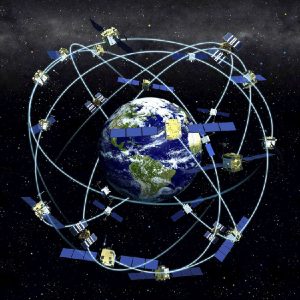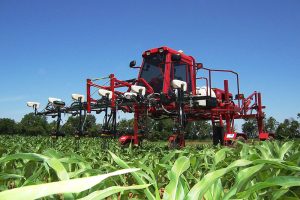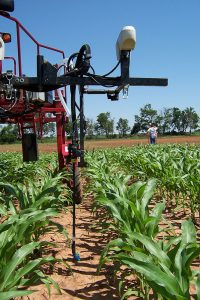Bulletin #1080, An Introduction to Using Site-Specific Farming to Manage Field Variability
Assistant Professor of Sustainable Agriculture Lakesh K. Sharma, Crops Specialist James Dwyer, and Associate Extension Professor Andrew Plant, University of Maine Cooperative Extension, and Dave Franzen, Extension Soil Specialist, North Dakota State University
For information about UMaine Extension programs and resources, visit extension.umaine.edu.
Find more of our publications and books at extension.umaine.edu/publications/.
Conventional farming practices overlook spatial and temporal variability within the farm. Treating a whole farm as a single unit can result in over-fertilization and under-fertilization of areas with differing residual nutrient levels, as well as unnecessary insecticide/herbicide applications in areas where no insect/weed problem exists. Satellite imagery and small flying units (drones and raptors) have shown promising results to detect the difference between nutrient deficiencies and insect/weed problems. Site-specific farming has the potential to increase farm income and resolve environmental issues, thus easing farm management decisions.
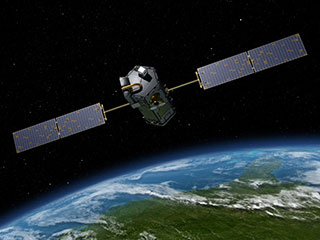
Whether you are farming conventionally or organically, sustainability can be achieved through precision agriculture, with its site-specific approach. By guiding growers to apply inputs based on the problems and yield potential of a specific area within a field, efficiency is increased through reduction of application rates, time, energy, and costs.
Site-specific thought is soils-oriented. It takes into account the differing soil properties caused by human and natural activities — including past agronomical practices — within each field. Such differing soil properties are unavoidable and cause crop production fluctuations within the field. Consider the ease with which a farmer can detect differences in soil color by simply standing in a field. Site-specific management is used to identify specific soil differences, collect information about them, and then change management practices, such as input requirements, in response.
Adopting the Site-Specific Approach
Many farmers think that site-specific farming tools are highly expensive and difficult to use, making them impractical in dryland agriculture systems. However, studies at various land grant institutions, including North Dakota State University (Franzen et al, 2015, Sharma et al, 2015, Sharma et al, 2014), Oklahoma State University (Raun et al, 2005), and the University of Nebraska–Lincoln (Schepers et al, 1992), have proved that the high level of precision enabled by site-specific tools results in lower costs, better yields, and more net income. For example, ground-based active optical sensors (GBAOS) have been successfully calibrated in North Dakota, Oklahoma, Nebraska, and Missouri for side-dress nitrogen application in corn. (Note that these states have adopted zone and grid soil-sampling techniques that help farmers identify low and high fertility areas for variable-rate fertilizer applications before or at planting.)
Site-specific farming requires farmers to think ahead and think differently than conventional farm practices do. It involves some important steps that must be followed properly:
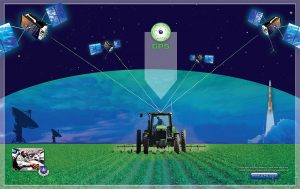 Finding your location through the use of Global Positioning System (GPS) receivers, Global Information System (GIS) mapping, ground-based sensors, and/or satellite imagery
Finding your location through the use of Global Positioning System (GPS) receivers, Global Information System (GIS) mapping, ground-based sensors, and/or satellite imagery- Evaluating your location by gathering information
- Applying variable-rate inputs
Finding Your Location and Mapping It
Global Positioning System (GPS)
GPS technology is in use throughout the world. It functions through a system of satellites — developed by the U.S. Department of Defense — that transmit signals to any receiver on earth. By measuring the amount of time it takes for signals from multiple satellites to reach a GPS receiver, the receiver can calculate its location in three-dimensional position (latitude, longitude, and altitude).
Depending upon the capabilities of the receiver, a GPS can determine location with a precision of a few inches to a few feet. Small errors in exact coordinates can occur, but readings can be improved using “differential GPS” (DGPS). In northeastern Maine, real-time kinematic (RTK) GPS systems are available that improve the precision of GPS data and are ideal for horizontal and vertical applications such as water drainage, auto steering, strip tilling, and mapping. RTK systems need either a base station or a subscription to a company (such as Verizon), that provides base-tower signals for GPS receivers.
Advantages of GPS
- Enables seedling rate management according to high/low yield potential areas of the field
- Helps achieve straight rows while avoiding double-planting, double-cultivating, and double applications of fertilizers and chemicals
- Helps in variable-rate nutrient application
- Enables yield monitoring
Global Information System (GIS)
GIS technology can be used to prepare maps that show the variability of specific nutrient parameters within certain areas of land, which helps manage variable-rate applications. A GIS can compile the data from soils analysis and crop yield to predict the nutrient/lime requirement of a specific area. Using GPS coordinates, GIS maps can be very useful in determining the variability of any farmer’s field without even leaving the office. GIS maps are generally prepared by the remote sensing industry; contact your soil surveyor or agricultural services staff for assistance.
Other Tools
Ground-based active optical sensors can measure plant biomass and give readings in the form of Normalized Difference Vegetative Index (NDVI). The development of an algorithm is required to use these sensors. They have been successfully used in wheat and corn for yield prediction and in real-time N rate application. University researchers with access to at least three years of data can develop the necessary algorithms.
Satellite imagery is another tool that uses NDVI data to manage nitrogen (N) requirements, but it has the disadvantage that images cannot be obtained during cloudy weather. Its precision is inferior to ground-based active optical sensors.
Evaluating Your Location by Gathering Information
There are several highly efficient ways to gather information and evaluate a field. Information about the field can be gathered by using sampling techniques, or with various types of sensors. Use of sensors is very common these days, but there is some information — such as nutrient analysis for pre-planting fertilizer application — that is best determined by soil sampling. However, active optical sensor and tissue sampling could be used for in-season nutrient applications. On a commercial scale, sensors for the following applications are readily available:
- Real-time ground-based active optical sensors for in-season applications, remote imagery, unmanned avionics systems (UAV), and satellite images
- Yield monitors
- Soil electrical conductivity sensors
- Sensors for measuring soil compaction
- Real-time soil pH sensors
Applying Variable-Rate Inputs: Choosing the Right Tools
Variable-rate controllers are available for need-basis input application. All kinds of fertilizers (liquid, granular, etc.) could be varied depending on crop need. Existing equipment can be modified for site-specific input applications. Variable-rate equipment could range from a full-sized commercial fertilizer applicator to a personal seeder. Most controller consoles have compatibility with many input/planting application devices, but checking with the manufacturer to determine which one will work best with your situation is a wise choice. The data-controlling device could be more like a small computer. Most companies have trained staff to help growers in the selection of appropriate tools for site-specific farming.
References
Franzen, D.W., Sharma, L.K., Bu, H., 2014. Active Optical Sensor Algorithms for Corn Yield Prediction and a Corn Side-dress Nitrogen Rate Aid. NDSU Extension Circular SF1176-5. (accessed 12.2015).
Raun, W.R., Solie, J.B., Stone, M.L., Martin, K.L., Freeman, K.W., Mullen, R.W., 2005. Optical sensor-based algorithm for crop nitrogen fertilization. Commun. Soil Sci. Plant Anal. 36, 2759–2781.
Schepers, J.S.; Blackmer, T.M.; Francis, D.D. Predicting N fertilizer needs for corn in humid regions: Using chlorophyll meters. In Predicting N Fertilizer Needs for Corn in Humid Regions. Bull. Y-226; Bock, B.R., Kelley, K.R., Eds.; National Fertilizer and Environmental Research Center: Muscle Shoals, AL, USA, 1992; pp. 105–114.
Sharma, L.K., H. Bu, A. Denton, and D.W. Franzen. 2015. Active optical sensors using red NDVI compared to red edge NDVI for prediction of corn grain yield in North Dakota, USA. Sensors (Basel Switzerland) 15:27832–27853. doi:10.3390/s151127832.
Sharma, L.K., Franzen, D.W., 2014. Use of corn height to improve the relationship between active optical sensor readings and yield estimates. Precision Agric. 15, 331–345. http://dx.doi.org/10.1007/s11119-013-9330-9.
Information in this publication is provided purely for educational purposes. No responsibility is assumed for any problems associated with the use of products or services mentioned. No endorsement of products or companies is intended, nor is criticism of unnamed products or companies implied.
© 2016
Call 800.287.0274 (in Maine), or 207.581.3188, for information on publications and program offerings from University of Maine Cooperative Extension, or visit extension.umaine.edu.
In complying with the letter and spirit of applicable laws and pursuing its own goals of diversity, the University of Maine System does not discriminate on the grounds of race, color, religion, sex, sexual orientation, transgender status, gender, gender identity or expression, ethnicity, national origin, citizenship status, familial status, ancestry, age, disability physical or mental, genetic information, or veterans or military status in employment, education, and all other programs and activities. The University provides reasonable accommodations to qualified individuals with disabilities upon request. The following person has been designated to handle inquiries regarding non-discrimination policies: Director of Equal Opportunity and Title IX Services, 5713 Chadbourne Hall, Room 412, University of Maine, Orono, ME 04469-5713, 207.581.1226, TTY 711 (Maine Relay System).


